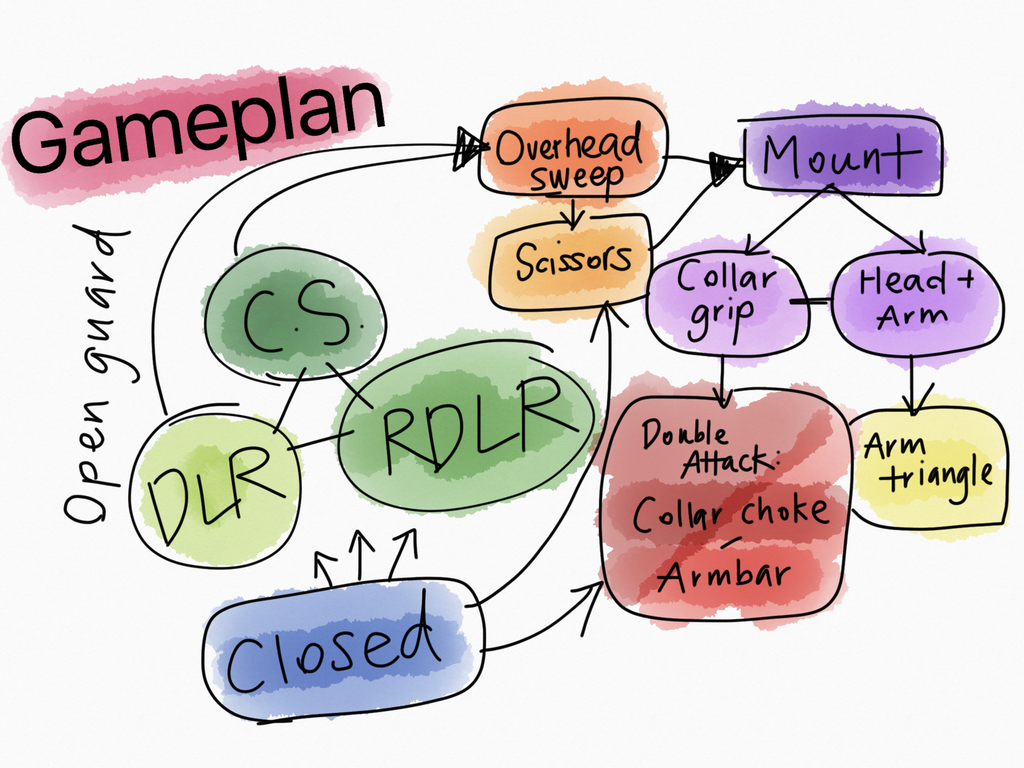How to Fully Develop Your Grappling Gameplan
A gameplan can be one of the greatest tools for a grappler, especially competitors, but there are right and wrong ways to build one. Follow this advice the next time you revise your gameplan:
Build mini gameplans and sub-systems
Your gameplan will be more useful as a collection mini gameplans rather than a single 99 technique long chain. By chunking your techniques and combinations into clusters, you will have an easier time both thinking of how the modules fit together and representing them in your visual flowchart.
Examples:
- Back attack system revolving around acquiring a seat belt grip.
- Open guards that connect to each other to combo sweeps and submissions.
- Standing guard pass system with answers to specific guards if needed.
- Submissions-as-positions strategies for armbars, triangles, kimuras, omoplata, etc.
Stay open to new additions
Your gameplan is not set in stone, not matter how many hours you spend mapping it out in FreeMind. It will always be evolving as you improve, learn more, and run into new problems to solve. You will always be discovering new techniques and positions you’d like to work on. Your gameplan can help you prioritize which to focus on first, and how they will fit into your existing knowledge base. Be willing to return to a technique you didn’t quite like the first time, because (assuming it’s a good technique), your earlier gameplan may not have had a good spot for it yet, or your skill level was not high enough at the time to fully appreciate it.
Trim the fat and cut the fluff
Developing your unique grappling style is not just about addition, but subtraction. Your gameplan can become bloated, especially if it’s mostly a mental exercise or a list of techniques you wish you were good at. Cutting out “nice to have” techniques can be tough but you will benefit from simplifying your decision trees and simplifying what you should work on in your practice time.
Account for Murphy’s law
Gameplans are built on the premise that you are mostly getting to do what you want, only branching as you run into problems and solve them, but always progressing towards you winning. Reality is rarely so kind. You should probably go back to the sub-system step and do that for all your escapes from bad positions. Survival, defenses, and escapes are not sexy, but they will keep you alive until you can get back on track.
Techniques are not all that matters
Techniques are basic building block of a gameplan, but BJJ is not just about knowing a bunch of techniques. The further you progress in BJJ, the less it becomes about collecting techniques and the more it becomes about refining the ones you already know, as well as developing less concrete attributes like intuition, timing, sensitivity, good instincts, and awareness.
Become a generalist with specialties
Early specialization as a beginner or intermediate grappler is tempting because it offers the promise of cheap success. As a competitor, this is especially appealing because it can be easier to “become a black belt” in one technique than it is to become a black belt at everything. Many upsets by lower belts competing against black belts come from hyper-specialized gameplans. How specialized you become is up to you, but I recommend you keep broadening your skills so you do not eventually find yourself becoming a one trick pony. You want a few secret weapons hidden up your sleeve, but you also need to be prepared for whatever the world throws at you.
Work on skills outside your primary gameplan
During your day-to-day training, especially when no big competitions are coming up, you should be open to working on techniques you do not yet consider part of your “A game.” Work on your “B game” and even C, D and even E games. Experiment and explore unfamiliar positions in rolling. You can always tighten up as you ramp up to compete or when you want to cut the fat.
Making up a gameplan does not make it a reality
What you put on paper does not matter until you put it into action. Use your gameplan to direct your drilling and training time. Now that you have it written down, it’s time to go put in the reps and the hours of mat time.
Other articles:
Quick links
Contact us
About us
Quality BJJ gear at fair prices, available all year. Founded in 2012 to provide an alternative to high-cost, limited edition gis. Dive into the BJJ lifestyle with us—join the Panda Nation!"

